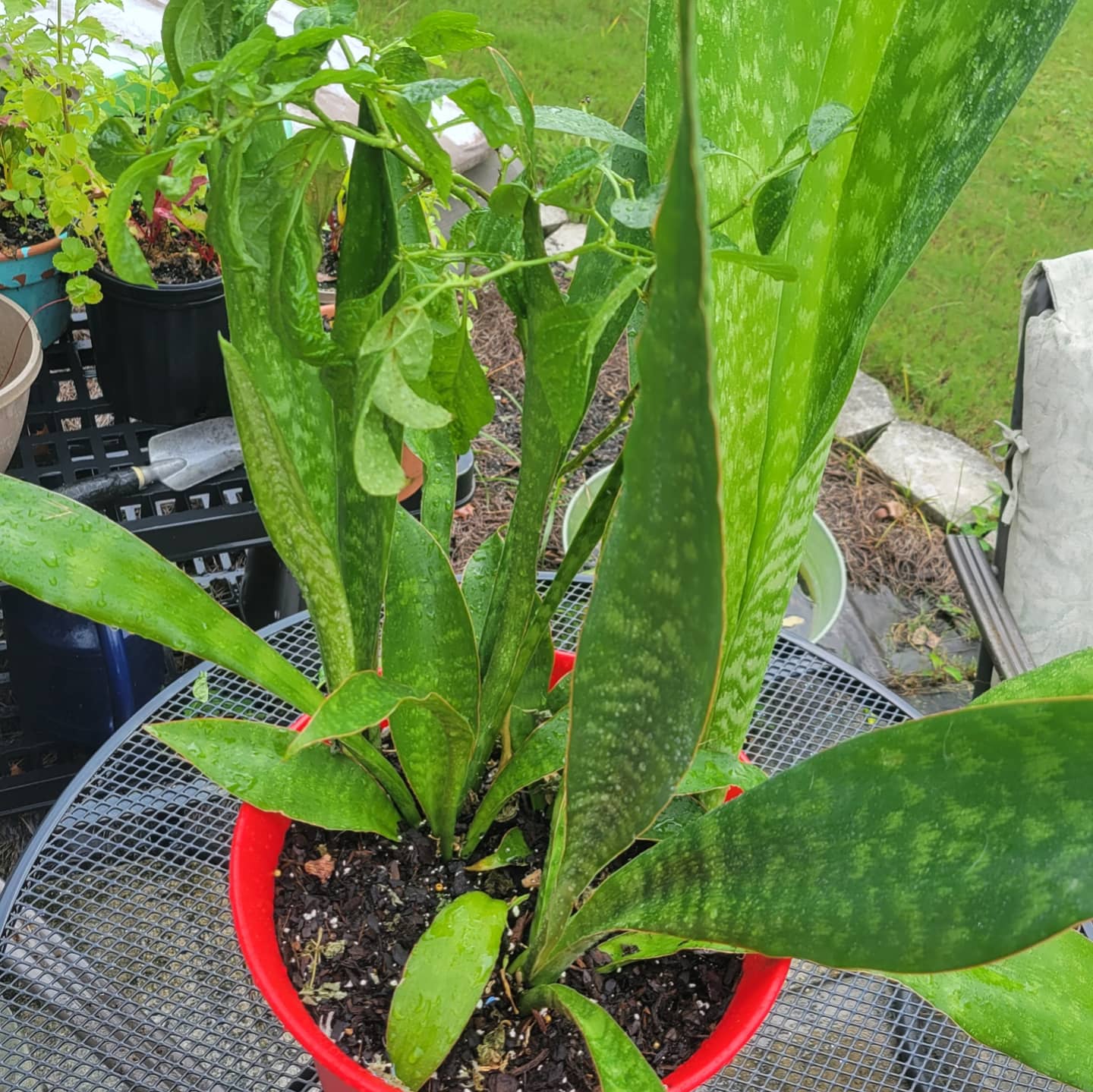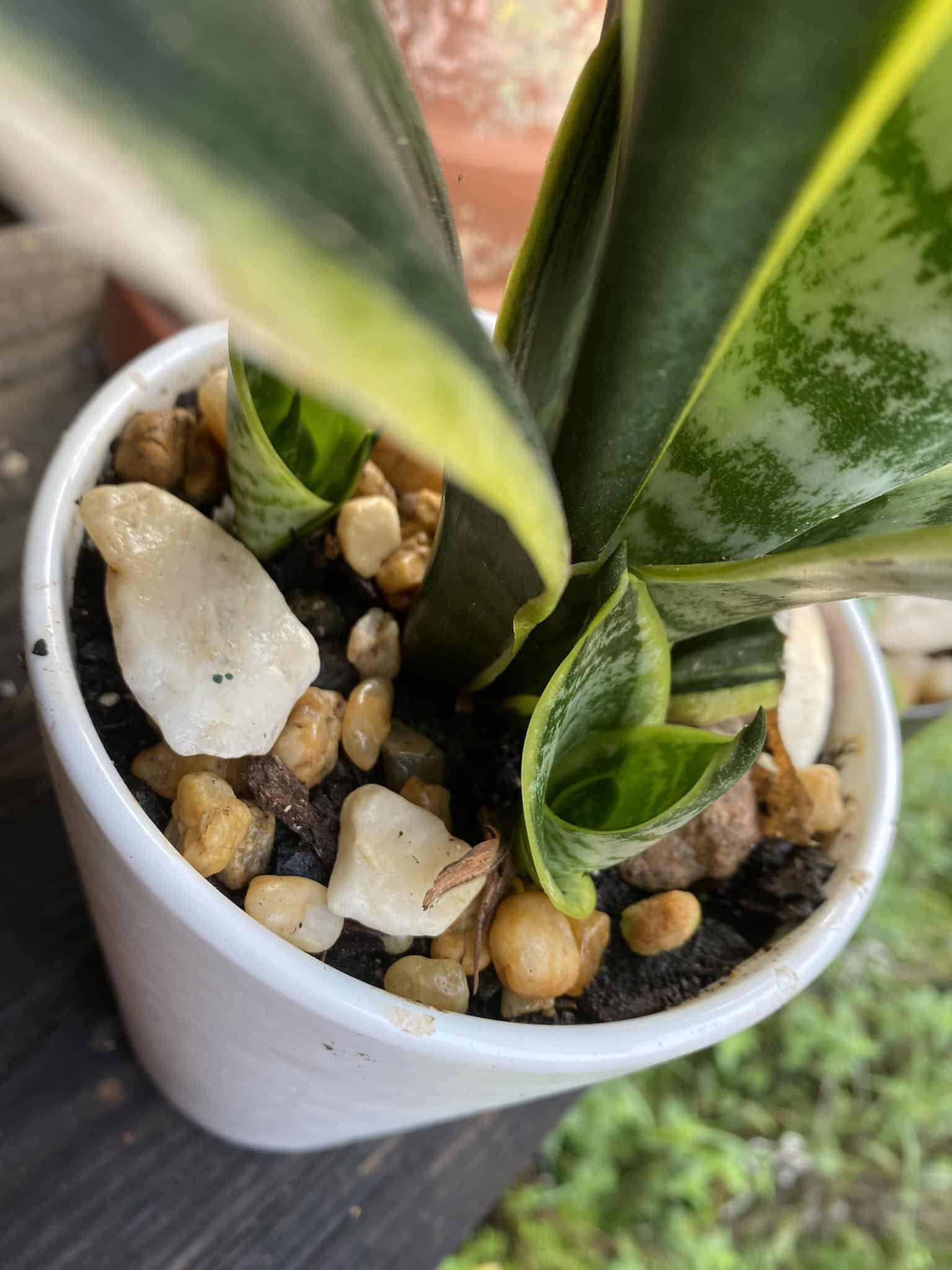Do you fear that growing Snake Plants outsides will get burnt? Actually, Snake Plants can live both indoors and outside and bloom flowers if given proper care.
Growing these succulents outdoors can be a Herculean task; hence, you should know your way around.
Table of Contents Show
Can Snake Plants Live Outside Like Indoor?
Snake Plants (Dracaena) are tropical succulents native to West Africa that were first introduced to the world in 1794 as houseplants.
Also known as “Mother-in-Law’s tongue,” these succulents store water in their sharp, pointed leaves, which helps prevent transpiration when the weather gets too hot.
First, let us know more about Snake Plants.
| Factors | Specifiation |
|---|---|
| Scientific name | Dracaena trifasciata, previously Sansevieria |
| Origin | West Africa, from Nigeria to Congo |
| Varieties | Over 70 varieties inc. African bowstring, banana, black coral, black gold, etc. |
| USDA Zone | 9-11 |
| Height/Width | 1-3 feet / 2-3 feet wide |
| Leaf color | Primarily green with some silver or yellow streaks |
| Bloom color | White/cream to greenish-white or yellow |
| Bloom period | Spring |
| Toxicity | Toxic to pets and humans |
| Grow season | Spring and summer |
How to Grow Snake Plants Outdoors? [Grow & Care Guide]
Your Snake Plant will love being outside in the sun, but needs additional care and maintenance.
Here is an overview of an excellent care guide for your Snake Plant.
 5-8 hours of bright filtered sunlight |  Once in 14-15 days in the spring and summer and once a month in winter |
 Well-draining, light loamy soil pH level: 5.5-7.0 |  Diluted 10-10-10 fertilizer once a month |
 60°F-70°F (15.5°C to 24°C) |  40-60% of humidity |
 Once every 3-4 years |  Propagate via leaf-cutting and division |
1. Optimized Sunlight
Snake Plants thrive in bright lighting, specially filtered sunlight, for at least 5 hours daily.
Remember, too much light and direct sunlight can lead to sun scalding and transpiration of leaves, causing leaves to curl and stop growing altogether quickly.

Similarly, low light can stop your Snake Plant’s growth and produce lanky stems and yellowed or droopy leaves due to a lack of chlorophyll.
Therefore, place your Snake Plant in a sunny location outdoors that receives some morning sunlight, such as a shaded patio or near a tall companion plant.
- When growing these succulents in full sun, avoid moving them from a low-light area to direct sunlight too quickly.
- Instead, gradually introduce them to direct light over 2-3 weeks and provide shade during the hottest day.
2. Moderate Temperature
Snake Plants ideally thrive in a warm climate as they fail to grow when the temperature dips too low.
Care to provide an ideal temperature range of 60-70°F during the day and nothing less than 55°F at night.
However, the same cannot be said about outdoor Snake Plants, as you cannot control the environment.
Witnessing wrinkled leaves due to transpiration is common in warm areas or during the hottest summer, usually exceeding 85°F.
Similarly, cracking, yellowed leaves, and brown leaf edges indicate the plant suffers from cold stress, usually below 50°F.
Therefore, ensure to grow your Snake Plant outdoors only if you live in a warm region, USDA 10 or above.
- Otherwise, move your plant to the brightest corner of the garden, which receives direct sunlight for at least a few hours a day.
- Consider planting your Snake Plant in a pot made of heat-retaining material, such as ceramic or terracotta.
- Adding a layer of the mulch around the base of the plant helps regulate soil temperature and prevent heat loss.
- Additionally, move your plant indoors in late fall and winter, and use an LED grow light to provide additional warmth and lighting.
3. Regular Watering
These succulents do not require excessive watering; you should only water them enough to ensure their roots get enough moisture.
Remember, Snake Plants store water inside their glossy leaves, and overwatering will overkill their ability to consume water.
You could tell it by their bloating leaves or mushy leaf at the bottom due to the root rot problem.
Likewise, severe under-watering will leave your Snake Plant dehydrated and stunted.
Therefore, the frequency of watering your outdoor Snake Plant will depend on the lighting, climate, and conditions.
- Check the soil moisture level and water the plant when the top 1-2 inch of the soil feels dry to the touch.
- During hot and dry weather, you may need to water more frequently, usually once weekly.
- Those growing in normal lighting conditions would require watering once every two weeks in the growing season.
- During cooler and rainy weather, you may need to water less often, usually once a month or more.
4. Moderate to High Humidity
Snake plants are humidity-loving plants and thrive in high-humidity surroundings.
Providing humidity around 40-60% can benefit their growth and overall health as it prevents transpiration.
However, achieving moderate humidity outdoors can be challenging, leading your plant to lose water more quickly.
You can tell your Snake Plant is suffering from low humidity problems from the following signs:
- Leaf curling or twist
- Brown leaf tips and crispy appearance
- Slow or stunted growth
- Pest problems such as spider mites.
If you suspect your Snake Plant is experiencing humidity and stress outdoors, here are handy tips to make them comfortable.
- Place the pot in a humidity tray to boost the humidity level around the plant.
- Group Snake Plants with other houseplants.
5. Well-Draining Substrate
The soil mix or substrate you choose for the outdoor-grown Snake Plant is essential in maintaining its growth.
Snake Plants prefer well-draining soil that allows excess water to drain quickly, as these succulents are susceptible to root rot.
You can tell your plant suffers from an excessive watering problem when it exhibits yellowing leaves, decayed leaf tips, mushy leaf bottom, and slowed or stunted growth.

Similarly, the soil will look dry and slightly cracked.
Here are a few ways to ensure well-draining soil for your Snake Plant.
- Choose a potting mix designed explicitly for cacti or succulents, as they promote moderate drainage and are low in organic matter to prevent fungal growth.
- Amend the soil with perlite or sand to help improve drainage and aeration.
- Ensure the pot has drainage holes and is the appropriate size for your Snake Plant: a pot too large can lead to excess water buildup.
- Make a schedule for watering your Snake Plant or when the soil feels dry.
6. Regular Fertilization
Outdoor-grown Snake Plants may require more frequent fertilizing than indoor ones to combat nutrient leaching and pest problems.
However, they still do not require as much fertilizing as other plants because they are slow growers.
Feed your outdoor-grown Snake Plants once or twice a year, during the growing season, or once a month with the diluted solution.
The frequency of fertilizing may depend on the soil quality and the amount of rainfall or irrigation the plant receives.
If your Snake Plant is exposed to frequent rainfall, the chances are that the soil is leaching nutrients.
- Before administering a fertilizer, check for signs of undernutrition, including slow growth, small leaves, and pale or yellowing foliage.
- Cut back on fertilization in hot summer as the excess chemical can damage the plant.
- Stop feeding the plant if you witness overfertilized signs such as browning tips, fronds, and wilting, yellowing foliage.
Apply the fertilizer according to the instructions on the label, and ensure to water thoroughly afterward.
Here are a few recommendations for commercial fertilizers: Schultz Cactus Plus Fertilizer, Miracle-Gro Indoor Plant Food, etc.
Conversely, if your plant grows in rich soil with plenty of organic matter or compost, it may not require as much fertilizing.
7. Potting and Repotting
Whether they live outside or indoors, Snake Plants should be repotted when they get root-bound, usually every two to three years or more when growing indoors.
Therefore, ensure to repot Snake Plants in a larger pot with a fresh potting mix every 2-3 years in spring or early summer.
Similarly, choose a well-draining substrate that is not too heavy or compacted to maintain proper soil drainage.
Here are a few tips for repotting Snake Plants.
- Choose a pot an inch bigger than the previous one with multiple drainage holes.
- Mix the potting soil well and fill the pot to half. Slide the plant from the pot and remove the soil attached to the roots.
- Using a sterilized pruning shear, trim away dead, decayed, mushy, and brown roots.
- Insert it root-first into the fresh soil mix; pour the rest of the soil until the bottom leaves. Allow it to sit for a few days or weeks to anchor the soil before watering.
8. Occasional Pruning
Snake Plants typically do not require frequent pruning, but occasional trimming in spring or summer can help them thrive.
Those grown outdoors are prone to pests like mealybugs, spider mites, and scales that suck the juicy sap, leaving your plant looking wilted, marked, and weak.
Similarly, overwatered or stressed Snake Plants become prone to fungal leaf spots and bacterial blights, indicated by brown or black spots, wilting leaves, and a water-soaked appearance on leaves.
Here are some proven tips for treating pests and diseases infested Snake Plants.
- Remove the dead or yellowing leaves as they appear, including pest and disease-infested foliage.
- Use a neem oil or insecticidal soap to treat the pest according to the instructions on the label.
- Treat the plant with a systemic fungicide or bactericide according to the instructions on the label.
- Ensure good air circulation around the plant to prevent pests and diseases.
FAQs Regarding Outdoor Snakes
Can Snake Plants be propagated outdoors (What is the best method)?
Snake plants can be propagated outdoors only through root division, which involves separating the parent plant into smaller sections and replanting them.
Is it okay to leave Snake Plants outdoors during winter?
Snake plants are hardy and can tolerate a low temperature of 50°F.
They are sensitive to frost and freezing temperatures, requiring moving to a warm location, such as indoors.
From Editorial Team
Conclusion!
To make Snake Plants live well outside, provide well-draining soil, bright but indirect sunlight, moderate watering, and protection from frost.
Prune damaged leaves and watch for signs of pests or disease. Most importantly, protect these succulents from extreme temperature, wind, direct lighting, and frost.


